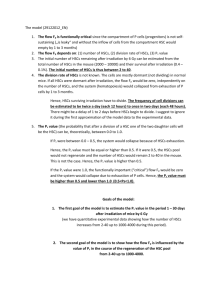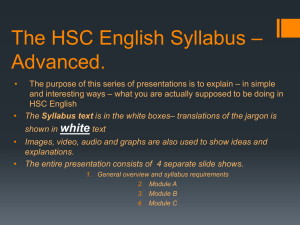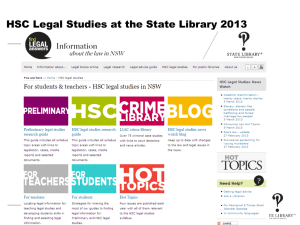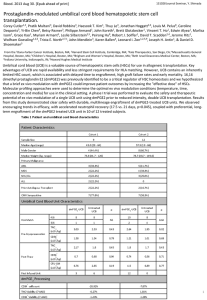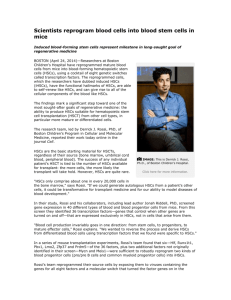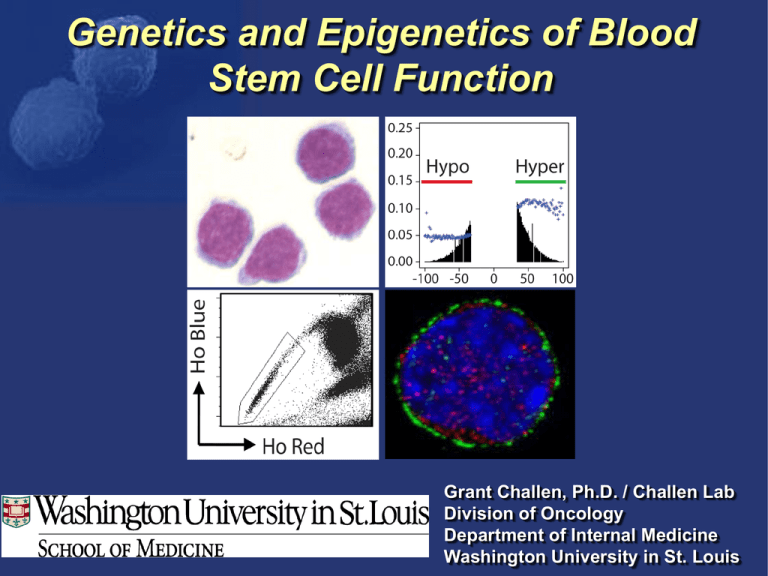
Genetics and Epigenetics of Blood
Stem Cell Function
Grant Challen, Ph.D. / Challen Lab
Division of Oncology
Department of Internal Medicine
Washington University in St. Louis
Hematopoietic
Stem Cells
LT-HSC
B-cells
NK-cells
T-cells
Granulocytes
Megakaryocytes
Monocytes
• Regenerate the blood
• Long-term self-renewal
• Multi-lineage differentiation
Platelets
Erythrocytes
The Importance of HSCs in Basic Research and
Clinical Practice
• Bone Marrow Transplantation
o Most clinically successful stem cell therapy
o In USA more than 18,000 patients require BMT each year
• HSC development / cancer mechanisms
o Many of the genes pathways critical for HSC function are also involved in
hematopoietic malignancies (e.g. leukemia, lymphoma)
o Understanding the normal functions of these genes in HSC biology will help
deduce the effect of mutations in disease
Rossi et al., Cell Stem Cell, 2012
• Paradigm for other stem cell systems
o Well-defined system – markers, assays etc…
o Many of the discoveries in HSC biology translate to other somatic stem cell
systems
HSCs are Tightly
Regulated by Intrinsic and
Extrinsic Factors
Rossi et al., Cell Stem Cell, 2012
LYMPHOID
B-cells
NK-cells
T-cells
LT-HSC
MYELOID
Monocytes
Clonal
Diversity
Model
Granulocytes
Platelets
Erythrocytes
Heterogeneity in the HSC Compartment
Dykstra et al., Cell Stem Cell 2007
Sieburg et al.,Blood 2006
Contrasting functional outputs from
phenotypically similar HSCs
Gradient of Activity Within the SP
HSC Activity
1
2
3
4
0
Can Hoechst dye efflux discriminate
functionally distinct HSC subtypes?
750 1,500 2,250 3,000 3,750
52 weeks after transplant
Goodell et al., Nature Medicine 1997
Single Cell Transplantation
WBM
WBM
Tri-lineage?
L-SP
U-SP
18 / 65
15 / 76
27.7%
19.7%
Tri-lineage?
Long-Term Self Renewal?
Engraftment
Peripheral Blood 12-weeks Post-Transplant
Lower-SPKLS
Upper-SPKLS
Myeloid-biased
Lymphoid-biased
**
*
*
*
* *
Lineages
*
Myeloid
B-cells
T-cells
Secondary Transplants - 12-weeks
L-SP
Lineage bias is a stable phenotype
U-SP
Myeloid
B-cells
T-cells
Lineage Bias
Myeloid
T-Cells
B-Cells
SP powerfully
discriminates
these activities
Physiological Relevance
•
Aging -
•
•
Old HSCs show myeloid bias
Could this result from proportional changes in the HSC subtypes?
Myeloid bias with age results from predominance of
My-HSC type rather than intrinsic change
Molecular Regulation of HSC Subtypes
•
Microarray Analysis -
•
•
•
TGFb signaling pathway enriched in My-HSCs
Both inhibitory and stimulatory for HSCs
Due to different effects on HSC subtypes?
in vitro culture – 5-hours
in vivo injection – 12-hours
My-HSCs
PBS TGFb1
Ly-HSCs
PBS TGFb1
Effect of TGFb1 on HSCs in vitro
Myeloid-biased HSC
Lymphoid-biased HSC
Difference mainly due to effect on CFU-GM colonies
LYMPHOID
Aging
Myeloid
Lymphoid
Dye stain
Self-renewal
Proliferation
TGFb1 response
• Stable
• Unionized
MYELOID
Artur Pappenheim
1905
“Stamzelle”
Differences –
Molecular
Functional
Phenotypic
Epigenetic
Neumann, Maximow
“Unitarians”
Paul Erlich
“Dualists”
Ramalho-Santos & Willenbring
Cell Stem Cell 2007
Epigenetic Factors are Differentially Expressed
in HSC Subtypes
Lower-SPKLS
Upper-SPKLS
434 Genes
351 Genes
Jarid1a
Jarid1b
Jarid1c
Suz12
Jmjd1c
DNA methyltransferase 3a
(Dnmt3a)
Ehmt1
Ehmt2
Epc1
Phc3
Nsd1
DNMT3A Mutations in Hematopoietic Malignancies
• de novo AML ~22%
• MDS ~10%
• T-cell lymphoma ~11%
• T-ALL ~18%
Epigenetic Mutations in
Hematopoietic Diseases
Histone Modifications
DNA Methylation
Mutated Gene
Function
Disease
IDH1, IDH2
isocitrate dehydrogenase
MPN, MDS, AML
TET2
methylcytosine dioxygenase
MPN, MDS, AML
EZH2
H3K27me3 methyltransferase
MPN, MDS, AML, ALL
ASXL1
chromatin-binding protein
MPN, MDS, AML
MLL
H3K4me3 methyltransferase
AML, ALL
DNMT3A
DNA methyltransferase
AML, MDS, T-ALL
DNA Methylation
• Addition of methyl group to CpG dinucleotides
• Functions –
> Silencing “foreign” DNA
> X-chromosome inactivation
> Genomic imprinting
> Gene silencing / activation
• Epigenetic regulation of gene transcription – CpG Islands
• Leukemia –
> Global and gene-specific aberrant methylation
> Hypermethylation and silencing of tumor suppressor genes
> Amenable to pharmacalogical reversion (5-aza-D / decitabine)
DNA Methyltransferase Enzymes
• Dnmt1 =
“maintenance” methyltransferase
• Dnmt3a / Dnmt3b =
“de novo” methyltransferases
Jones & Liang, Nature Genetics, 2009
Full-Length Dnmt3a is Highly
Expressed in HSCs
Dnmt3a may have
unique functions
in HSCs
LT-HSCs
Conditional Deletion of Dnmt3a Does
Not Affect Steady-State Hematopoiesis
pIpC Injections
Mx1-cre:Dnmt3afl/fl
Mx1-cre:Dnmt3a
/
6 injections every other day
WBCs
crecre+
RBCs
crecre+
Platelets
crecre+
Kaneda et al., 2004, Nature
Dnmt3a Male Mice
= pIpC injections
= 5-FU injection
Testing HSC Potential in vivo
CD45.2 conditional
knockout donors
1o
CD45.1 wild-type
competitors
CD45.1 Recipients
2o
CD45.1 Recipients
200,000 whole
bone marrow cells
250 purified
HSCs
4 weeks
Check
4 weeks
pIpC
Injections
8 weeks
5-6 weeks
200,000 whole
bone marrow cells
CD45.1 wild-type
competitors
4 week
intervals
Deletion
250 purified
HSCs
12 weeks
Monitor
FACS
10
Marrow
16 weeks
Repeat for serial
transplantation
2o Transplant
Transplant
Dnmt3a-KO HSCs show greater
contribution to peripheral blood
Mice transplanted with Dnmt3a-KO
HSCs have an expanded HSC pool in
the bone marrow
# of Donor-Derived
HSCs / mouse (x103)
%Donor-Derived
Blood Cells
1o
1o
2o
Enhanced Activity in Serial Transplants
Reflects Expanded HSC Pool
Expanded Dnmt3a-KO
HSCs phenotypically
resemble normal HSCs
Progenitors
Stem Cells
Mechanism for Accumulation of Dnmt3a-KO
HSCs in the Bone Marrow?
• Apoptosis?
X
• Proliferation?
X
Dnmt3a-KO HSCs Do Not Show Proportional
Differentiation With HSC Content in Serial Transplantation
Loss of de novo DNA Methylation Skews the Balance
Between Normal HSC Self-Renewal and Differentiation
DIFFERENTIATION
16-weeks post-transplant:
AMPLIFICATION
Blood donor cell chimerism by flow cytometry
Total animal WBC count by CBC
Number of donor-derived HSCs in the bone marrow
Amplification per HSC (~self-renewal)
= number of CD45.2+ HSCs in the bone marrow / number of
original input donor HSCs
Differentiation per HSC
= total WBC count of recipient mouse X Donor cell engraftment in
Normal
Dnmt3a-KO
peripheralHSC
blood / number of donor
HSCs in the HSC
bone marrow
Enhanced HSC Activity is Cell Autonomous
Single CD45.2+ SPKLS/CD150+ from transplanted mice sorted
into individual wells of 96-well Methocult plates
Transgene Deletion
PCRs in HSC Clones
Gene Expression Changes in Dnmt3a-KO HSCs
Methylation Profiling Dnmt3a-KO HSCs
MS-HPLC
Dnmt3a-KO HSC Methylation
RRBS
Control HSC Methylation
Hypomethylation of HSC
multipotency genes
Dnmt3a-KO B-cells Show Incomplete Repression of
“HSC Genes”
MS-HPLC
HSCs
DREAM
Hypomethylation
and expression of
HSC genes in
differentiated cells
Dnmt3a represses the
“stem cell program” in
HSCs to permit lineage
differentiaton
B-cells
Vasn, Runx1
Mycn, Ptpn14, Src, Vwf, Vldlr, Prdm16
Dnmt3a-KO HSCs Cannot Silence “HSC Genes” For
Efficient Long-Term HSC Differentiation
Venezia et al., 2004, PLoS
Vasn, Runx1, Nr4a2
Pathogenesis
LT-HSCs
Signal for
differentiation
Vasn – B-cells
Control
Vasn - HSCs
Dnmt3a
• Upregulated “HSC multipotency” genes
Dnmt3a-KO
• Both hyper- and hypo-methylation in HSCs
X
• Hypo-methylation
and
incomplete
Dnmt3a
repression of “HSC genes” in KO B-cells
Challen, Nature Genetics, in press
Summary
• The HSC pool is composed of distinct subtypes which can be
discriminated based on Hoechst efflux
• Dnmt3a is required to epigenetically silence the stem cell genetic
network in HSCs to allow efficient differentiation
Clinical Significance
• DNMT3A mutations prevalent in MDS, AML, T-cell lymphoma, T-ALL
• Targets of Dnmt3a methylation represent potential for personalized
medicine or prognostic indicators
Future Directions
• Interaction between Dnmt3a / DNA methylation and other epigenetic
modifications
• Identify co-operating mutations in mouse models of Dnmt3a pathology
Goodell lab - BCM
• Peggy Goodell
• Jonathan Berg
• Allison Rosen
• Mira Jeong
• Min Liu
• Chris Benton
• Wei Li
• Deqiang Sun
Funding $$$
Challen Lab – Wash U
• Andy Martens
• Cates Mallaney
NIH – NIDDK R00DK084259
American Society of Hematology
Alex’s Lemonade Stand
Children’s Discovery Institute
ASXL1
• Additional sex combs like 1 (Drosophila)
• Chromatin binding protein, polycomb-like properties
• H2AK119 deubiquitase activity
• Loss of function mutations –
o 10-15% of myeloproliferative neoplasms (MPN)
o 15-25% of myeldysplastic syndrome (MDS)
o 10-15% of acute myeloid leukemia (AML)
The goals of this study were to determine the effects of ASXL1
mutations on ASXL1 expression as well as the transcriptional and
biological effects of perturbations in ASXL1 which might contribute
towards myeloid transformation
Leukemia ASXL1 mutations are loss-of-function
ASXL1 and BAP1 physically interact in
human hematopoietic cells but BAP1 loss
does not result in increased HoxA gene
expression
ASXL1 loss is associated with loss of
H3K27me3 and increased expression of
genes poised for transcription
Rescue of leukemic cell lines with ectopic expression of ASXL1
Rescue of leukemic cell lines with
ectopic expression of ASXL1
ASXL1 interacts with the PRC2 complex in hematopoietic cells
ASXL1 silencing co-operates
with NRasG12D in vivo in a
mouse model of AML
Summary / Conclusions
•
ASXL1 mutations in myeloid leukemia patients and myeloid cell lines
are loss-of-function.
•
Loss of ASXL1 leads to reduced H3K27me3 repressive chromatin
and increased HOXA gene expression.
•
ASXL1 physically interacts with PRC2 and recruits to target genes
Subsequent epigenomic studies of human malignancies will likely
uncover novel routes to malignant transformation in different
malignancies, and therapeutic strategies that reverse epigenetic
alterations may be of specific benefit in patients with mutations in
epigenetic modifiers


